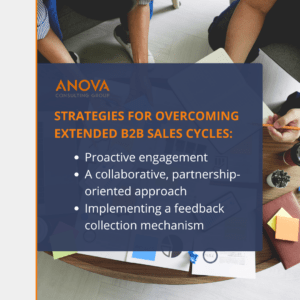
Thursday, August 1, 2024
 This blog was written by Brian McMahon, Consultant at Anova.
This blog was written by Brian McMahon, Consultant at Anova.
It’s not just you. Anyone involved in B2B sales over the past couple of years has experienced the frustration of deals that simply never seem to close.
Sales cycles are certainly lengthening, and the data backs it up. Below are just some of the statistics that demonstrate this unfortunate shift in how buying decisions are being made.
Purchase Process Stalls: According to Forrester, nearly 90% of global B2B buyers indicated a purchase process stall in 2023, underscoring the complexities and delays inherent in today’s sales environments.
Deal Stagnation: In 2023, approximately 60% of deals ended up in no decision, highlighting the growing trend of prolonged decision-making processes and the hurdles faced by sales teams in closing deals.
Information Overload: 63% of buyers feel overwhelmed with information, while 74% express that there are too many options to consider, creating barriers to swift decision-making and contributing to sales cycle extensions.
Buying Team Dynamics: The average buying team size ranges between approximately 7 individuals, as reported by HBR, to a substantial 14 – 23 people, according to Gartner, emphasizing the intricate dynamics and diverse stakeholders involved in B2B purchasing decisions.
This reticence to buy is a roadblock to closing and developing business, and with this challenge, client retention and expansion of course becomes a major focus. Listed here are some of the key reasons why client retention is increasingly vital in the face of these lengthy sales cycles:
Stable Revenue Streams: Retaining existing clients ensures a consistent flow of revenue, mitigating the impact of deal stagnation and purchase process stalls on overall business performance.
Cost-Effectiveness: The cost of acquiring new customers is significantly higher than retaining current ones, making client retention a cost-effective strategy, especially in environments characterized by prolonged sales cycles.
Cross-Sell and Upsell Opportunities: Satisfied clients are more receptive to cross-selling and upselling efforts, presenting lucrative opportunities to expand product / service offerings and increase customer lifetime value.
To retain clients an organization has to keep them satisfied as well as continually deliver value. Over the thousands of client satisfaction, renewal, and pre-RFP interviews Anova has done, the most effective strategies in doing so are:
Proactive Engagement: Foster regular communication, personalized interactions, and proactive problem-solving to strengthen client relationships and enhance loyalty.
Collaborative, Partnership-Oriented Approach: Adopt a collaborative mindset by aligning with clients’ goals, providing strategic guidance, and co-creating solutions to build trust and empower your clients, which enhances client loyalty.
Implement a Feedback Collection Mechanism: Ensure you catch developing pain points as quickly as possible and identify areas for opportunity within existing clients by continuously providing them avenues to provide feedback on the relationship.
If you demonstrate to your client you are a true partner looking to grow with them and empower and enable them along the way, it puts you in an ideal position to sell additional, value-added services that are closely aligned with their needs and goals.
As B2B sales cycles continue to lengthen and challenges such as purchase process stalls, prioritizing client retention emerges as a strategic imperative for sustained business success. By leveraging client retention strategies, businesses can expand from outside the complexities of extended sales cycles, capitalize on cross-sell and upsell opportunities, and cultivate enduring partnerships that drive growth and resilience in today’s competitive landscape.